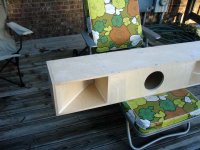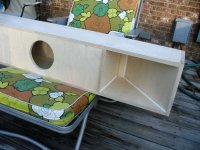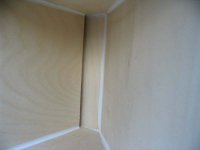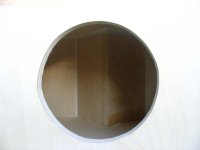Hi all, I've been browsing around this site for a couple of years now dreaming of what my first speaker project would be. I finally decided to go with the G Chang design from Frugal Horn since I wasn't at the point where I felt confident to build one of my own designs (that will come next, hopefully.)
I have finished building the box. I used 3/4" baltic birch plywood as I was able to get it for next to nothing and a friend's dad owns a woodworking company and was nice enough to let me use his shop so the box turned out very well.
The places where screws were used have been filled in with Bondo and the pictures were taken before I started sanding. Since the pictures were taken I have sanded all surfaces with 120 grit sandpaper and then applied the 2nd layer of Bondo.
The finish will be a high gloss finish of some color. I originally thought of the traditional piano gloss black. Since then I thought of trying something a bit more unique, as to what that might be, I haven't figured out yet, but I've got about a week of priming and sanding to figure it out.
I've included some pics to show the progress. Also I wasn't sure if there was anything I needed to know above and beyond the plans to make this project be even better. I'll be using the fostex 207's and the phase plugs.
I have finished building the box. I used 3/4" baltic birch plywood as I was able to get it for next to nothing and a friend's dad owns a woodworking company and was nice enough to let me use his shop so the box turned out very well.
The places where screws were used have been filled in with Bondo and the pictures were taken before I started sanding. Since the pictures were taken I have sanded all surfaces with 120 grit sandpaper and then applied the 2nd layer of Bondo.
The finish will be a high gloss finish of some color. I originally thought of the traditional piano gloss black. Since then I thought of trying something a bit more unique, as to what that might be, I haven't figured out yet, but I've got about a week of priming and sanding to figure it out.
I've included some pics to show the progress. Also I wasn't sure if there was anything I needed to know above and beyond the plans to make this project be even better. I'll be using the fostex 207's and the phase plugs.
Attachments
Indeed. Wish I could build like that. Come to think of it, wish I could build anything at the moment, as my work area & what few tools I had have now departed this life.
Let us know what you think of them.
Let us know what you think of them.
Well, I had great help form a friend who does custom woodwork for a living. Plus his amazingly equipped shop helped produce what you see there.
I've finished the Bondo and initial sanding and the first coat of primer is on and drying. I'm hoping to power these with the Tubelab SE, so that'll be the next project after this. Is there anyone here who have built these? I'm just looking for opinions of what the strong points of these are.
I've finished the Bondo and initial sanding and the first coat of primer is on and drying. I'm hoping to power these with the Tubelab SE, so that'll be the next project after this. Is there anyone here who have built these? I'm just looking for opinions of what the strong points of these are.
Just out of curiosity, what is the audible difference between using the solid piece of 45 degree wood in the outer horns and having the stair stepped wood stack? I just did whatever was the easiest to make but wonder if there is a big difference between the 2.
Any difference would be solely mass related (more mass, greater stability). Sand filling the cavity behind the single piece deflector would give move mass....
dave
dave
I sand filled the open cavities of a pair of Bk 161's and regretted how heavy they became. Back breaking to get up the stairs! With your even larger speaker project i recommend asking a friend to help you move them around after they are finished. I even considered building handles into my BIBs but found they were not as heavy and fairly easy to hump around. The speakers look great and should sound amazing!
Actually, in theory there will be some differences between the angled strike plate & the stepped pieces due to the latter causing some shearing on the wavefront with resultant HF noise (or so I gather from GM). Whether or not it's audible depends on the design & whether you find the benefit of greater / a different type of mass / bracing in those locations preferable. Differences are subtle, so it's mostly an aesthetic question.
Looks nice! Would love to hear them once you get them completed. Where are you in NC?
Care to share your cheap BB source? Mine in Charlotte has dried up.
Mark
Care to share your cheap BB source? Mine in Charlotte has dried up.
Mark
Tarhead, love it. Although I've been called a tarlung, but for vastly different reasons.
The shop where I built these receive scrap pieces slightly bigger than the largest piece used on the box for next to nothing from some builder in Charlotte. If I remember correctly it was a piano company or something?
I'm rearranging my garage right now to accomidate these speakers so I don't have to keep lugging them outside to sand and paint them, so I hope to have them finished in the next 2 weeks. I also need to drill the holes to fill the cavities with sand so that's 4 more holes that need Bondo!
The shop where I built these receive scrap pieces slightly bigger than the largest piece used on the box for next to nothing from some builder in Charlotte. If I remember correctly it was a piano company or something?
I'm rearranging my garage right now to accomidate these speakers so I don't have to keep lugging them outside to sand and paint them, so I hope to have them finished in the next 2 weeks. I also need to drill the holes to fill the cavities with sand so that's 4 more holes that need Bondo!
As pertaining to the straight or stacked wood in the mouths, just from what I know about fluid dynamics (which is not that much) but it would seem that the stair step model would exhibit turbulence as the air passes over each step, not allowing for fluid airflow out of the mouths. I know that some speaker designers deal with this same principal with ported type speakers and that the ports have some of the same properties and the turbulence there does effect the sound. Not sure what this would translate to in the aural world, but it seems to me that the straight piece would be the better way to go from an airflow perspective.
Scottmoose said:Actually, in theory there will be some differences between the angled strike plate & the stepped pieces due to the latter causing some shearing on the wavefront with resultant HF noise (or so I gather from GM). Whether or not it's audible depends on the design & whether you find the benefit of greater / a different type of mass / bracing in those locations preferable. Differences are subtle, so it's mostly an aesthetic question.
Scottmoose said:See post 14
Of course one could always cut the "steps" at the exact calculated angle or fabricate the lower deflector as a block of solid wood, but not this cowboy.
Anyone game to build a pair with each method to test audibility / advantage of one over the other? Me neither - I've been taking the lazy way out lately, and ballast fill the void cavities. In the case of a double mouth design, I'd be inclined to add a wider base plate and use lighter fill for the top cavity to lower the center of mass - a 6ft tall x 1ft wide box can get a bit tippy.
- Status
- Not open for further replies.
- Home
- Loudspeakers
- Full Range
- First (real) speaker project





